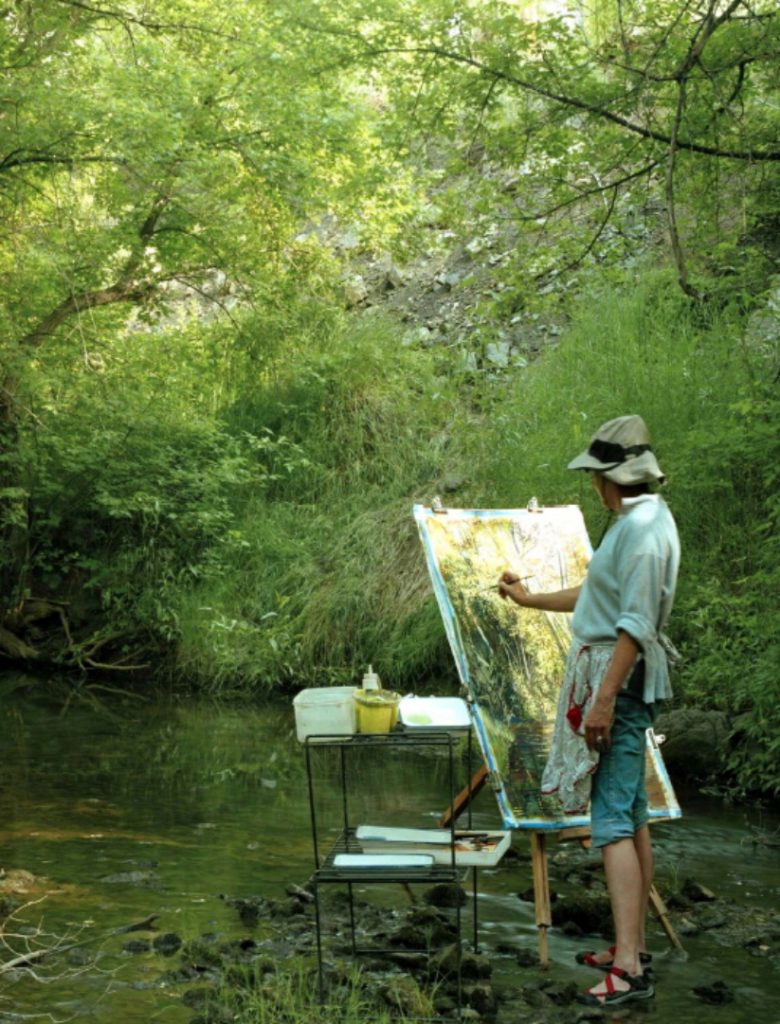Artist statement
“It is only in appearance that time is a river.
It is rather a vast landscape and it is
the eye of the beholder that moves.”
—Thornton Wilder
I paint in plein air. I look for seemingly pristine landscapes, pockets of wilderness. All evidence of human impact— roads, buildings, old trucks— are intentionally left out. By avoiding depictions of the detritus of human activity the viewer is left with a more expanded sense of scale.
Both landscapes (large) and cloudscapes (small) are started and completed on site, without reliance on photography or even on-site sketching. The goal for both subjects— vast skies, intimate forest interiors— is to balance pictorial clarity with subtle tonal relationships. The compositions form the tonal armature in which an entirely imagined color palette is embedded. The range of values— luminance— is shaped by observed reality and the limitations of pigment. The application of color however, is imagined, sensory, intuitive, and .… intelligent. My painterly fidelity to luminance gives these landscapes the initial appearance of belonging to photographic realism— they do not.
Cloudscapes, completed within the comfort and safety of my car, are all-season affairs. They are quickly completed, using dry media, wax pastels and markers. I chase dramatic skies: bloody sunsets, walking rain, clouds, celestial rays. In other words, bombast!
The large paintings— forest interiors— are labor-intensive. I stand and look, think, and paint, for a few hours a day over a number of days. I paint primarily in gouache, a medium of remarkable fluency. Gouache is very supple, very ‘fast,’ resulting in the kind of optical clarity that is essential for color and light/dark differentiation. As I paint I am challenged to ‘hear’ with my eyes: continually revising the changing luminance— the quantities of light or dark— of the scene before me. Shadows may form within shadows, or they may yield to sunlight altogether. Water may reflect vegetation and sky, or become transparent; but always water presents the challenge of indefinable color. As the angle of light changes, foregrounds alternate with backgrounds; highlighted features transform into silhouettes. Backlighting provides drama; filtered light offers a soulfulness or mood associated with tonalist painting.
If I’ve chosen the setting wisely and observed carefully, color, value, and shape metabolize into a deeply layered visual narrative. These paintings may present as ‘photographic,’ primarily because of the range of values that are far greater than are displayed in most landscape painting. They capture a sense of frontal exposure and intimacy we might associate with portraits. They may incite the pleasure of looking.
Finally, because these paintings don’t directly address or depict toxic changes to our wilderness, (more a function of documentary photography), they could be could be said to represent an idealized, one could even say naive, perspective , and are at risk of irrelevancy. However, as an artist who has traveled and painted extensively throughout the southwest I have witnessed how our environment is being degraded at its edges as well as its core by escalating human activity. Places I have painted are no longer pristine, or don’t even exist anymore. I, and my paintings, serve as a witness to the solitude, beauty, and fragility of the wilderness under our domain.
